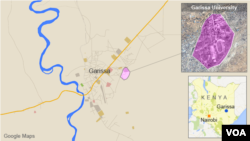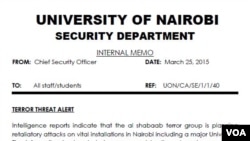Kenyan officials said Thursday that a daylong siege at a university in the country's northeast was over, leaving 147 people and four Islamist al-Shabab terrorists dead.
Police and survivors said the gunmen stormed the campus of Garissa University College, about 370 kilometers (230 miles) east of Nairobi, and opened fire "indiscriminately."
But some students said the attackers were separating the Christians from the Muslims and holding them hostage.
Security forces surrounded the campus and battled the militants for 15 hours, rescuing more than 500 students trapped by the violence.
At least 79 people were injured, and many were airlifted to Nairobi, Kenya's national disaster body said.
Interior Minister Joseph Nkaissery said the four gunmen had explosives strapped to their bodies and they blew up "like bombs" when police shot them.
Al-Shabab said the attack was revenge for Kenyan military action inside neighboring Somalia, where the Islamist militant group is based.
It was their most violent attack in Kenya since the 2013 terrorist strike on Nairobi's Westgate Mall, which killed more than 60 people.
The attack at the university “is one of those incidents that would surprise any country,” Nkaissery said. He ordered a dusk-to-dawn curfew in Garissa and in the nearby counties of Wajir, Tana River and Mandera — all near the Somali border.
Early morning attack
Witnesses said the assailants began the attack about 5 a.m. near the classrooms and then worked toward the residence halls.
The number of attackers initially was not clear, although witnesses reported seeing four or five armed men on campus. The Kenyan Interior Ministry said earlier that one suspect was arrested trying to flee the scene.
In a televised statement to the nation earlier in the day, President Uhuru Kenyatta said police and the Interior Ministry were coordinating the government response to the attack. He urged Kenyans to remain calm and give authorities any information they had in connection with all security threats.
Kenyatta also offered his condolences to the victims' families: “We continue to pray for the quick recovery of the injured and the safe rescue of those still being held hostage.”
A spokesman for the militants told the French news agency AFP that the group's mission was to "kill those who are against the Shabab."
The U.S. ambassador to Kenya, Robert Godec, said the United States "strongly condemns al-Shabab's heinous terrorist attack" and stood "shoulder to shoulder with the government and people of Kenya in the effort to end the scourge of terrorism."
Kenyan authorities named alleged al-Shabab commander Mohamed Kuno as the mastermind of the attack. A security brief seen by VOA said Kuno was a former madrassa teacher in Garissa in the late 1990s and was now said to be al-Shabab's chief for external operations against Kenya.
Student details attack
Students in campus housing were awakened Thursday by the sound of gunfire. Student Beatrice Mathai told VOA she and fellow students fled when they heard what she called a heavy exchange.
"We run from where we were, kneeled down and looked out towards the football club," Mathai said. "Finally, we jumped over the building’s wall. Before the attack we were 29 students, now we are seven. We are very frightened and even do not know where we are now."
Student Mercy Chebet told VOA she and other students evacuated the dormitories as the gunmen approached.
“It started in the classes and we were in the hostels sleeping, so when we heard the bullets, we just moved out of the hostels and ran to the field,” Chebet said. “When we were in the field, they came to the hostels and they were shooting where we were."
She said the gunmen then moved into the dormitories and began firing. She said she spoke by phone to some friends who were being held hostage inside.
Collins Wetangula, the vice chairman of the student union, told The Associated Press he was preparing to take a shower when he heard gunshots coming from Tana dorm, which hosts both men and women, 150 meters away.
He said that when he heard the gunshots, he locked himself and three roommates in their room. When the gunmen arrived at his dormitory, he could hear them opening doors and asking the people who had hidden inside whether they were Muslims or Christians.
“If you were a Christian, you were shot on the spot,” he said. “With each blast of the gun, I thought I was going to die.”
The gunmen then started to shoot rapidly and it was as if there was an exchange of fire, he said.
“The next thing, we saw people in military uniform through the window of the back of our rooms who identified themselves as the Kenyan military,” Wetangula said. The soldiers took him and around 20 others to safety.
Threat letter
The University of Nairobi warned its students last week that al-Shabab was planning attacks on Kenyan institutions, including a "major university."
In an email obtained by VOA with the subject "TERROR THREAT" dated March 26, the University of Nairobi's security office said information about a possible attack was "being processed by the relevant government agencies."
It is not clear yet that Garissa University received or posted the same warning.
The town of Garissa, in northeastern Kenya, is about 200 kilometers (125 miles) from the border with Somalia and has, in recent years, been the site of sporadic gun and grenade attacks blamed on al-Shabab.
Al-Shabab is known for assaults on large buildings, such as the Westgate Mall in Nairobi in 2013, and Somalia's presidential palace, which it attacked twice last year.
Last week, al-Shabab claimed responsibility for a deadly siege on a Mogadishu hotel that lasted more than 12 hours and in which at least 24 people, including six attackers, were killed.
Kenyatta announced that he would fast-track the training of 10,000 additional police, saying the country has “suffered unnecessarily due to shortage of security personnel.”
Also, Kenyan authorities are offering a $200,000 reward for Mohamed Mohamud, also known as Gamadhere or Dulyadayna. He is suspected to be al-Shabab's chief for external operations against Kenya and allegedly is connected to the Garissa attack.
Mohamed Farah Shire contributed to this report from Garissa. Some material for this report came from Reuters and AP.












